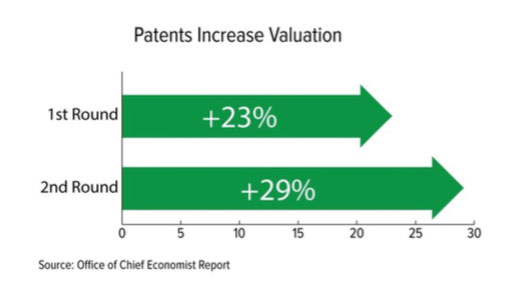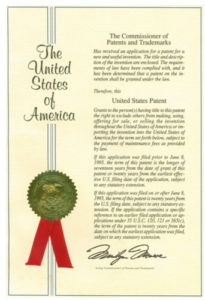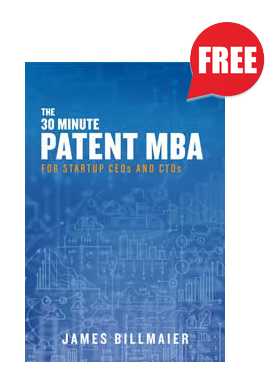This is the first in our series of chapter excerpts from the book The 30 Minute Patent MBA by Jim Billmaier. Want to get the full ebook for free? Grab it here.
Why bother with patents?
Why bother with patents? There are many reasons. Let’s go into the Top 11.
Data-proven substantial increase in likelihood of receiving funding
As an early-stage company your odds of obtaining first-round funding increases by 53% if you have invested in patents vs. early-stage companies without evidence of a patent strategy. With investment in a patent portfolio your odds of receiving funding in the second round are further increased by 67% over early-stage companies that did not use part of their first-round funding to create an IP advantage.

Data-proven substantial increase in funding valuations and exit valuations
As an early-stage company your valuation at the first round of funding increases by 23% if you have invested in patents vs. early stage companies without evidence of a patent strategy. With investment in a patent portfolio your average valuation in the second round is further increased by 29% over early-stage companies that did not use a portion of their first-round funding to create an IP advantage.

Data-proven substantial increase in likelihood of successful exit
As an early-stage company with a patent portfolio, your likelihood of a successful exit in the form of an acquisition increases by 83% vs. early stage companies without a patent portfolio. And your company’s odds of achieving an initial public offering (IPO) vs. a company without patents is increased by 153%.
Protection during discussions with investors, partners, and acquirers
In a perfect world, a startup CEO would be able to count on the protection provided by a nondisclosure agreement (NDA) for meetings with potential investors, partners, and acquirers. But the fact is that most potential investors won’t sign NDAs, leaving the startup disclosing its “secret sauce” without any protection. Filing provisional patent applications on core ideas prior to disclosing ideas to potential investors allows the savvy startup CEO to protect his or her company value proactively, without relying on VCs to keep the startup’s plans under wraps.Remember, those VCs meet with hundreds of entrepreneurs every year.
Potential partners and acquirers are almost always larger and more powerful than your company. So they usually get to decide what the nondisclosure agreement contains. All too often, these NDAs leave little real protection against these organizations who learn from your meeting only to create or enhance their own internal developments. Ever hear of a residual clause? Filing and prosecuting patent applications on the inventive technology that gives your company market differentiation and competitive advantage will give these organizations pause before they set about ripping off your ideas. It will also provide you with a path to recourse should they decide to do so.
Competitive advantage vs. copy-cats and fast followers
The instant your company files a provisional or non-provisional patent application, it can begin to mark the related products and services “PATENT PENDING.” This simple mark gives copycats pause. China’s government is now taking patent infringement much more seriously. Those Chinese or other offshore companies whose sole business is to make cheaper versions of the designs of others will more likely avoid copying, manufacturing, and distributing a patented or patent-pending product vs. a non-protected product.
Serves as trade currency in IP assertion matters against your company
As an early-stage or medium-sized company, one of the inherent advantages you enjoy vs. large entities is speed. However, large companies can use patent infringement assertion as a way to slow down or stop your company. If you have no patent assets, you have little trade currency with which to barter. With a well-built patent portfolio, you are actually in an interestingly strong position compared to large corporations. An injunction (stopping a company from shipping one of its products due to infringement of your IP) is far more financially damaging to a public company whose shareholder satisfaction is directly tied to the company’s financial results.
Stronger negotiating position in acquisition negotiations
I have seen a startup acquisition discussion go from the withdrawal of an offer to a completed deal of over $300 million. This occurred during an M&A evaluation where the large company’s engineering team concluded and reported to its management that it could rebuild the same solution in six months for approximately $1 million.
While this is an extreme case, it is common for another party, once it has deeply studied your product or service, to conclude that it could rebuild it far cheaper than it cost you to create it. The truth is that you could probably rebuild your own technology at a fraction of the cost that was required the first time.
The happy ending to this story is that the startup company had patented its key inventions, making it not only legally dangerous for the large company to simply copy the technology, but also impractical to work around the patents. As a result, the large company consummated an acquisition of the startup for $300 million!
Establishing “Patent Pending” or “Patented” for stronger market positioning
We have discussed how “Patented” or “Patent Pending” helps slow or stop fast followers from ripping off your special sauce. In addition, a patent mark sends a signal to the marketplace that you and your team have brought something special to the market—something different and better than competitive products.
Patent process results in a superior product definition and value proposition
Common questions asked in the process of creating IP around your company’s product or service are: “Why is your product/service better than what is in the market today?” And “What would your sales or marketing team say to potential customers as to why they should spend their time and money on your product or service as opposed to your competition’s?”
Most startups have a notion of the answers to these questions but often cannot state it in a clear and succinct fashion. Companies often spend tens of thousands or hundreds of thousands of dollars on consultants to help them create well-thought-out plans and messages to describe those plans. Startup companies that don’t have a rock-solid handle on their vision of their market differentiation will waste huge sums of money and misdirected company effort in product development and marketing.
The patent process forces deep thought and documentation on what is different and better about what your company is attempting to build. This is far cheaper than bringing in a marketing consultant, not to mention the wasted effort inherent in trying to decipher a hazy vision. Avoiding both are unintended upsides of working through the patent process early on. Even more, once that patent process is completed, your company not only has a very clear idea of its special sauce, it also has the legal means to protect that special sauce in the marketplace.
Demonstrates professionalism of management team
Patent applications are impressive documents. They contain specifications for how the special sauce can be developed, as well as drawings and other figures that express detailed thoughts and plans. Smart investors conduct a thorough assessment of how your engineering processes and methods are performed; they take a deep dive into your go-to-market plans and business model, etc. The smartest investors—and you do want the smartest money backing your company—investigate your company’s competitive advantage, including protecting your company’s most valuable inventions. This does not entail just studying a patent application or two that you may have in process, but rather the continual, repeatable and sustainable process and culture of protecting your company’s IP assets. Amateur founders and company executives deal with this in an ad-hoc manner, whereas professionals practice a disciplined approach to patents and trade secrets.
Team motivation
Being a named inventor on a granted patent brings a sense of pride. Patents allow members of your team to build demonstrable value in their careers and can be combined with simple and inexpensive invention reward programs that enhance employee satisfaction (specifics on reward programs addressed later). Establishing a culture of invention early on in your company’s development increases both the flow of innovation within your team and the value of your venture.

This has been an excerpt from the book The 30 Minute Patent MBA by Jim Billmaier. Used by permission of the author. Want to get the full ebook for free? Grab it here.





